Installing Driver / Software (Network Connection) (MF4570)
| Article ID: ART108864 | | | Date published: 05/11/2015 | | | Date last updated: 08/16/2015 |
Description
Solution
Installing Driver/Software (Network Connection)
The method of installation differs depending on the connection method or environment.
 IPv4 environment
IPv4 environment
See "Installing MF Drivers and MF Toolbox".
 IPv6 environment*
IPv6 environment*
See "Installing the MF Drivers via the WSD Network".
* The scan function is unavailable in IPv6 environment.
Installing the MF Drivers and MF Toolbox
User rights for logging on to Windows
- Log on as a user with administrative rights.
When installing via network connection
- Before starting the installation, check the following.
- The computer and machine are connected via the network.
- The power of the machine is turned ON.
- The IP addresses are properly set up.
Install this software to use the machine.
There are two methods for installing the software. Normally, install it with [Easy Installation].
To install the following software and manuals that cannot be installed with [Easy Installation], select [Custom Installation].
- Presto! PageManager
- e-Manual
 Installing with [Easy Installation]
Installing with [Easy Installation]
1. Insert the User Software CD-ROM.
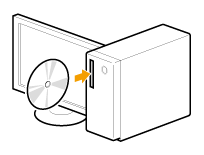
2. Click [Easy Installation].
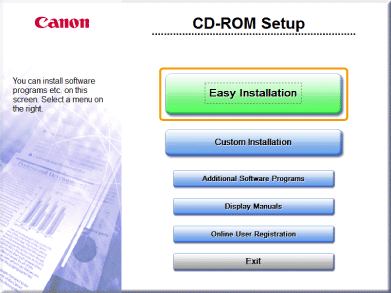
If the above dialog box does not appear
- If you cannot display the top screen when setting CD-ROM, perform the following operations.
* The CD-ROM drive name is indicated as "D:" in this manual. The CD-ROM drive name may differ depending on the computer you are using.



1. From the [Start] menu, select [Run].
2. Enter "D:\Minst.exe", and then click [OK].



1. Enter "D:\Minst.exe" in [Search programs and files] (or [Start Search]) under the [Start] menu.
2. Press the [ENTER] key on the keyboard.
If a language selection screen is displayed before the CD-ROM setup screen
- Select a language and then click [Next].
3. When the following screen appears, select the connection to a computer.
Click [Next] in [Connect Printer to Computer via Network].

4. Click [Install].
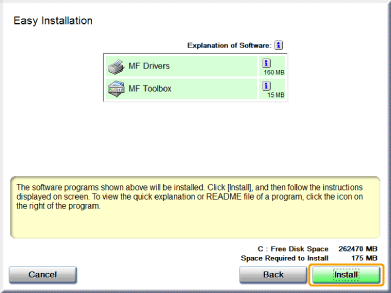
5. Read the contents of the License Agreement, and then click [Yes].
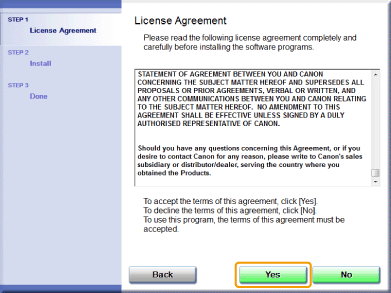
6. Click [Next].
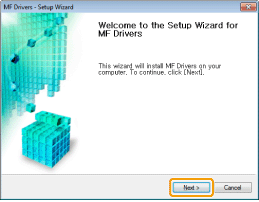
The following screen appears. Click [Yes].

7. Select the device to be installed.
(1) Select the device.
(2) Click [Next].
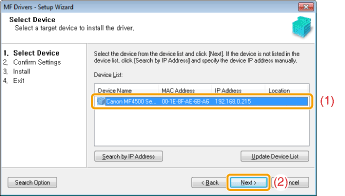
If no devices are displayed in [Device List]
- Perform the following procedure.
1. Check the following.
- The computer and device are connected via the network.
- The device is turned on.
- The IP address is set correctly.
- The computer and device are on the same subnet.
- Security software has been exited.
2. Click [Update Device List].
- If any devices are not displayed by performing the above procedure, perform the following procedure.
1. Click [Search by IP Address].
2. Enter the IP address of the device to be installed.
* If the IP address of the device is between "169.254.1.0 and 169.254.254.255", the IP address is the one assigned by the AutoIP function.
* If an IP address other than link-local addresses is set for the computer, set an IP address in the same subnet as the computer (other than link-local addresses) also for this machine manually. This enables the installer to search for this machine. [ ]
3. Click [OK].
8. Installation starts when clicking [Start].
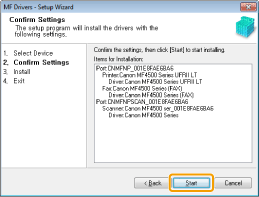


9. Click [Exit].

Next, installation of MF Toolbox starts.
* In Windows 2000 Server/Server 2003/2008, MF Toolbox is not installed. Proceed to Step 12.
10. Click [Start].
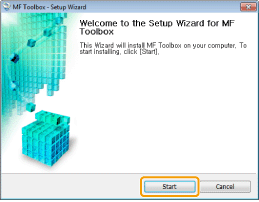
11. Click [Exit].
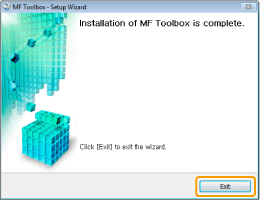
12. Check that [  ] is selected in [Install], and then click [Next].
] is selected in [Install], and then click [Next].
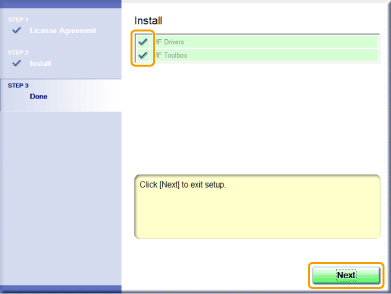
13. Restart your computer.
(1) Select the [Restart Computer Now (Recommended)] check box.
(2) Click [Restart].
* The CD-ROM may be removed once this screen appears.
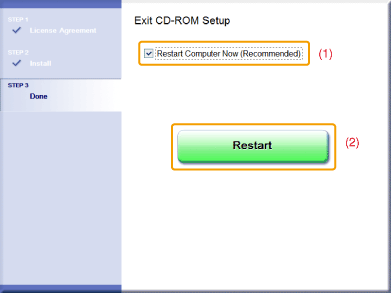
 Checking the installation results
Checking the installation results
Check that the MF drivers and MF Toolbox are installed correctly.
Check that the icons for the installed software are added as follows.
| Software | Location | Icon |
| Printer driver | [Devices and Printers] folder |  |
| Fax driver | [Devices and Printers] folder |  |
| Scanner driver | [Scanners and Cameras] or [Scanners and Cameras Properties] folder |  |
| MF Toolbox | Desktop |  |
| Network Scan Utility | Taskbar |  |
 Installing with [Custom Installation]
Installing with [Custom Installation]
1. Insert the User Software CD-ROM.

2. Click [Custom Installation].
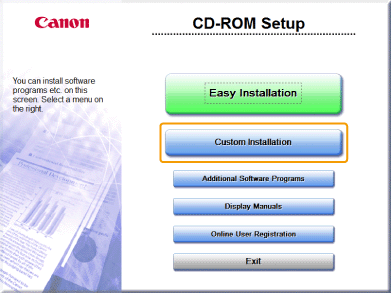
If the above dialog box does not appear
- If you cannot display the top screen when setting CD-ROM, perform the following operations.
* The CD-ROM drive name is indicated as "D:" in this manual. The CD-ROM drive name may differ depending on the computer you are using.



1. From the [Start] menu, select [Run].
2. Enter "D:\Minst.exe", and then click [OK].



1. Enter "D:\Minst.exe" in [Search programs and files] (or [Start Search]) under the [Start] menu.
2. Press the [ENTER] key on the keyboard.
If a language selection screen is displayed before the CD-ROM setup screen
- Select a language and then click [Next].
3. When the following screen appears, select the connection method to a computer.
Click [Next] in [Connect Printer to Computer via Network].

4. Select the check box for the software to be installed, and then click [Install].
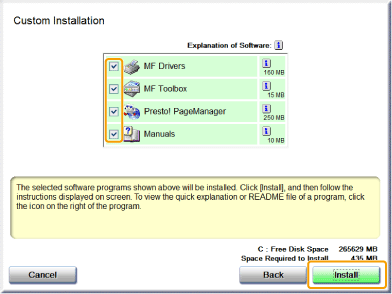
5. Read the contents of the License Agreement, and then click [Yes].

6. Click [Next].

The following screen appears. Click [Yes].

7. Select the device to be installed.
(1) Select the device.
(2) Click [Next].

If no devices are displayed in [Device List]
- Perform the following procedure.
1. Check the following.
- The computer and device are connected via the network.
- The device is turned on.
- The IP address is set correctly.
- The computer and device are on the same subnet.
- Security software has been exited.
2. Click [Update Device List].
- If any devices are not displayed by performing the above procedure, perform the following procedure.
1. Click [Search by IP Address].
2. Enter the IP address of the device to be installed.
* If the IP address of the device is between "169.254.1.0 and 169.254.254.255", the IP address is the one assigned by the AutoIP function.
* If an IP address other than link-local addresses is set for the computer, set an IP address in the same subnet as the computer (other than link-local addresses) also for this machine manually. This enables the installer to search for this machine. [ ]
3. Click [OK].
8. Select the function you want to use.
(1) Select the function you want to use (driver to be installed).
(2) Click [Next].

| [Printer] | Select when using the print functions. |
| [Fax (for Supported Models)] | Select when using the PC fax function. (This function sends documents or images that were created on a computer directly as a fax transmission.) |
| [Scanner] | Select when using the scan functions. |
9. Set the printer or fax information.
(1) Specify the settings for each option as needed.
(2) Click [Next].
Printer information*1



Fax information*2
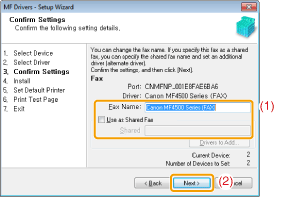
*1 Appears if you selected [Printer] in Step 8.
*2 Appears if you selected [Fax (for Supported Models)] in Step 8.
| [Printer Name] | Enter a new name if you want to change the printer or fax name. |
| [Fax Name] | |
| [Use as Shared Printer] | Select the check box to share the printer or fax. |
| [Use as Shared Fax] | |
| [Shared Name] | Change the shared name as needed. |
If you selected the [Use as Shared Printer] or [Use as Shared Fax] check box
- Install the additional driver as follows.
1. Click [Drivers to Add].
2. Select the operating system displayed in [Drivers to Add].

3. Click [OK].
* If a 64-bit operating system is running on a computer on which the installation is being performed, the download installation (installation from a network) for a client computer on which any of the following 32-bit operating systems is running is not supported due to a Windows restriction.
- Windows 2000
- Windows XP (on which no service pack or SP1 is installed)
- Windows Server 2003 (on which no service pack is installed)
* If you download and install the software on any of the above 32-bit operating systems, you may fail to install the software and may not be able to open the printing preferences dialog box.
* If any of the following 32-bit operating systems is running on a computer on which the installation is being performed, the additional driver for a 64-bit operating system cannot be installed.
- Windows 2000
- Windows XP (on which no service pack or SP1 is installed)
- Windows Server 2003 (on which no service pack is installed)
10. Installation starts when clicking [Start].



11. Select the printer used generally.
(1) Select the printer used generally.
(2) Click [Next].
* This screen appears only when installing the printer driver and fax driver.

12. Select to print a test page.
(1) Select the check box to print a test page.
(2) Click [Next].
* This screen appears only when installing the printer driver.

13. Click [Exit].

Next, installation of MF Toolbox starts
* In any of the following cases, MF Toolbox is not installed. Proceed to Step 16.
- If you are using Windows 2000 Server, Windows Server 2003, or Windows Server 2008
- If you cleared the [MF Toolbox] check box in Step 4
14. Click [Next].
The screens for specifying a location in which the MF Toolbox is installed and position to which the start menu is added appear.
Specify the settings in the respective screens, and then click [Next]. Click [Start] in the displayed screen.

15. Click [Exit].

The software for which the check box was selected in Step 4 is installed.
Follow the on-screen instructions.
16. Check that [  ] is selected in [Install], and then click [Next].
] is selected in [Install], and then click [Next].
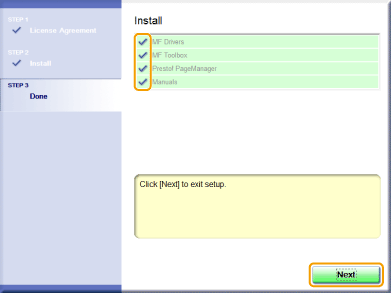
17. Restart your computer.
(1) Select the [Restart Computer Now (Recommended)] check box.
(2) Click [Restart].
* The CD-ROM may be removed once this screen appears.

 Checking the installation results
Checking the installation results
Check that the MF drivers and MF Toolbox are installed correctly.
Check that the icons for the installed software are added as follows.
| Software | Location | Icon |
| Printer driver | [Devices and Printers] folder |  |
| Fax driver | [Devices and Printers] folder |  |
| Scanner driver | [Scanners and Cameras] or [Scanners and Cameras Properties] folder |  |
| MF Toolbox | Desktop |  |
| Network Scan Utility | Taskbar |  |
Installing the MF Drivers via the WSD Network
When using Windows Vista/7/Server 2008, you can print using the WSD (Web Services on Devices) protocol. To use WSD, follow procedures in "Installing the MF Drivers" and "Setting WSD."
The network scan function is not available
- Scanning via the WSD network is not supported.
- Scan using the USB connection, or install the MF Drivers and MF Toolbox from the CD-ROM setup screen.
When operating in IPv6 environment
- You may not install MF Drivers from the CD-ROM setup screen.
- Follow the procedures in this section.
- To switch WSD on or off
- Use the operation panel on the machine. For details, see the "e-Manual" (HTML manual) in the CD-ROM supplied with the machine.
 Installing the MF Drivers
Installing the MF Drivers
1. Display the printer folder.

From the [Start] menu, select [Control Panel], and then click [Printer].


From the [Start] menu, select [Devices and Printers].

From the [Start] menu, select [Control Panel], and then double-click [Printers].
2. Click [Add a printer].

3. Click [Add a local printer].

4. Check if [LPT1: (Printer Port)] is displayed in [Use an existing port], and then click [Next].

5. Click [Have Disk].

6. Insert the User Software CD-ROM.

When the following screen appears, click [Exit].

If [AutoPlay] is displayed
- Click [
 ] to close the dialog box.
] to close the dialog box.
7. Click [Browse].

8. Open the folder in which the printer driver is.
 For 32-bit
For 32-bit
Open [DRIVERS] -> [us_eng] -> [32bit] -> [win2k_vista] in the supplied CD-ROM, and then click [Open].
 For 64-bit
For 64-bit
Open [DRIVERS] -> [us_eng] -> [x64] -> [Driver] in the supplied CD-ROM, and then click [Open].

If you do not know which of 32-bit or 64-bit system you are using
1.Select [Control Panel] from the [Start] menu.
2.Display [System].



Click [System and Maintenance] or [System and Security] -> [System].

Click [System].
3.Check the process version.
 For 32-bit version
For 32-bit version
[32-bit Operating System] is displayed.
 For 64-bit version
For 64-bit version
[64-bit Operating System] is displayed.

9. Click [OK].

10. Select [Canon XXXX Series UFRII LT], and then click [Next].
* "XXXX" varies depending on the model.

11. Specify a printer name.
(1) Enter a new name to change the name for the printer.
* If [Set as default printer] is displayed, select whether or not to use the machine as default printer. (Windows Vista/Server 2008)
(2) Click [Next].

m²Installation starts. Wait until the below screen disappears.

If [User Account Control] appears
- Click [Yes] or [Continue].
12. Select [Do not share this printer], and then click [Next].
* If you want to share the machine, perform the sharing settings after performing settings in "Setting WSD."

13. Click [Finish].
* If [Set as default printer] is displayed, select whether or not to use the machine as default printer. (Windows 7/Server 2008 R2)
* You may eject the CD-ROM when the below screen appears.

m²The icon is added to the printer folder.
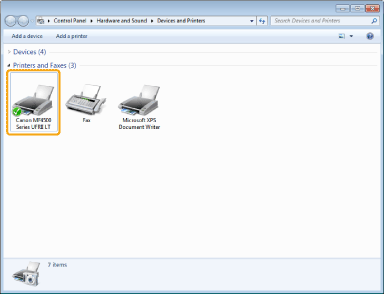
 Setting WSD
Setting WSD
1. Display the network folder.
 For Windows Vista/Server 2008
For Windows Vista/Server 2008
Select [Network] from the [Start] menu.
 For Windows 7/Server 2008 R2
For Windows 7/Server 2008 R2
Select [Computer] from the [Start] menu, and then click [Network].
2. Right-click the machine icon, and then select [Install] from the pop-up menu.

m² The icon is add to the printer folder. Installation is finished.

If [User Account Control] appears
- Click [Yes] or [Continue].
* Delete the icon that is added in the step 13 following the procedures below, as the icon will not be used.
(1) Right-click the icon, and then select [Remove device] or [Delete] from the pop-up menu.
(2) Click [Yes].
(3) If [User Account Control] appears, click [Yes] or [Continue].

